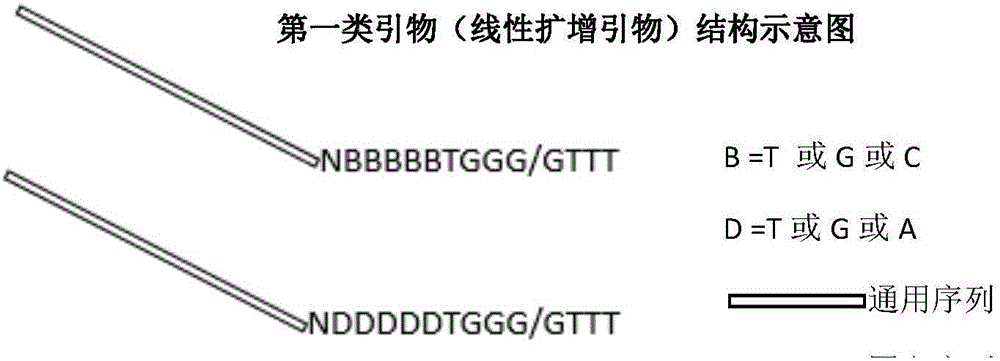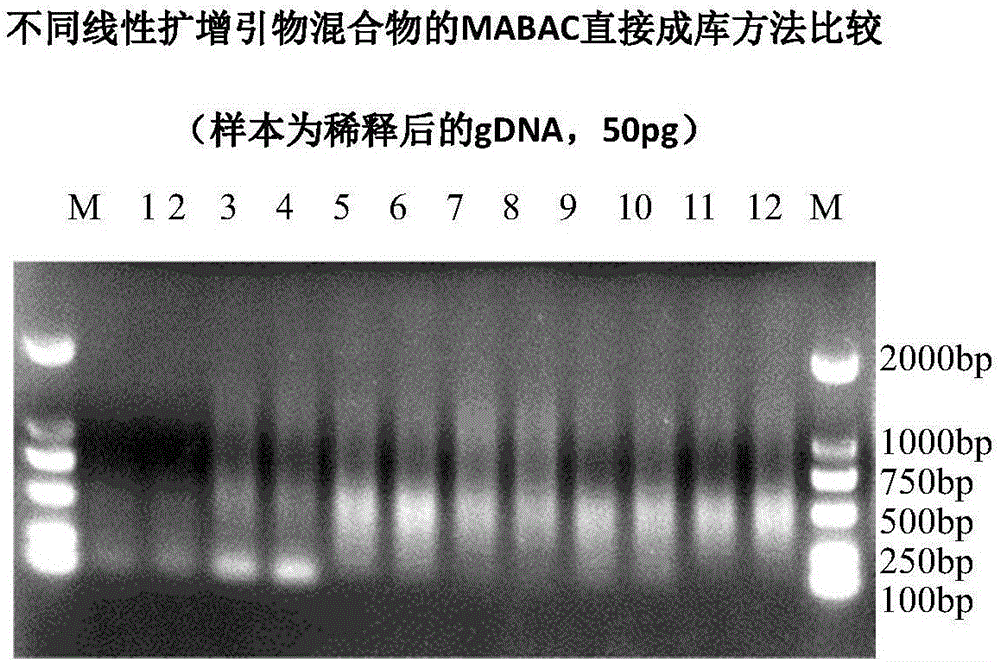Method for amplifying DNA
A technology for pre-amplification and amplification products, applied in the field of DNA amplification, can solve the problems of long time, cumbersome operation, complicated preparation process, etc.
- Summary
- Abstract
- Description
- Claims
- Application Information
AI Technical Summary
Problems solved by technology
Method used
Image
Examples
Embodiment 1
[0185] Example 1: Preliminary verification of amplification effects using different linear amplification primer mixtures
[0186] a) Validation using standard genomic DNA samples
[0187] The standard genomic DNA is the genomic DNA of human cells extracted in advance. Dilute the standard genomic DNA with nuclease-free water to a DNA solution of 50 pg / μl, take 1 μl of the above solution (as a source of genomic DNA) and add it to a PCR tube, and add it to each experimental group as shown in Table 1. The primer mix and other relevant reagents, obtain the first reaction mixture (which contains Na + , Mg 2+ , Cl - , Tris-Cl, TritonX-100, dNTPs, Vent polymerase and primer mix).
[0188] linear amplification
[0189] For each primer combination / mixture, two experimental groups were used to conduct parallel experiments to ensure its accuracy, and the reaction mixture of each experimental group was placed in the following first temperature control program for reaction:
[019...
Embodiment 2
[0229] Example 2: Further verification of amplification effects using different linear amplification primer mixtures
[0230] Human epidermal fibroblasts were isolated and lysed according to the method described in implementation 1b) to obtain single-cell genomic DNA, and the primer mix used in the experimental group 11 / 12 in Table 1 and the primer mix used in the experimental group 9 / 10 were used, respectively. The primer mixture was used for amplification, and 10 parallel experiments were performed for each primer mixture (represented as 1_1, 1_2...1_10 and 2_1, 2_2...2_10). Amplify according to the program described in embodiment 1a) and obtain the amplified product, and carry out gel electrophoresis detection to the amplified product, the electrophoresis detection result is as follows Figure 6 shown. Wherein the concentration of the amplified product in the experimental group 2_1, 2_2...2_10 is slightly lower than the concentration of the amplified product in the experim...
Embodiment 3
[0238] Example 3: Detection of pathogenic sites and quality inspection primers
[0239] Pathogenic site detection
[0240] 35 disease-causing loci were randomly selected (see Table 8 below for the selected loci), and primers were designed. The selected pathogenic loci and their corresponding primers are shown in Table 8 and Table 9, respectively.
[0241] Table 8: 35 randomly selected disease-causing loci
[0242]
Pathogenic site name
chromosome location
1
SMN1-1
chr5
2
SMN1-2
chr5
3
SMN1-3
chr5
4
SMN1-4
chr5
5
SMN1-1R
chr5
6
SMN1-2R
chr5
7
SMN1-3R
chr5
8
SMN1-4R
chr5
9
PDS-IV15
chr7
10
PDS-EXON5
chr7
11
PDS-EXON7+8
chr7
12
PDS-EXON10
chr7
13
PDS-EXON17
chr7
14
PDS-EXON19
chr7
15
HBB3
chr11
16
HBB
chr11
17
MMACHC
chr1
...
PUM
 Login to View More
Login to View More Abstract
Description
Claims
Application Information
 Login to View More
Login to View More - R&D
- Intellectual Property
- Life Sciences
- Materials
- Tech Scout
- Unparalleled Data Quality
- Higher Quality Content
- 60% Fewer Hallucinations
Browse by: Latest US Patents, China's latest patents, Technical Efficacy Thesaurus, Application Domain, Technology Topic, Popular Technical Reports.
© 2025 PatSnap. All rights reserved.Legal|Privacy policy|Modern Slavery Act Transparency Statement|Sitemap|About US| Contact US: help@patsnap.com



